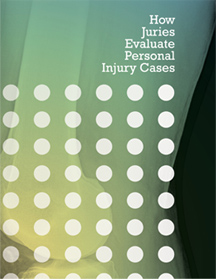Case evaluation examples based upon case severity
Units of disability
Insurance companies commonly evaluate general damages (damages for pain and suffering) by the amount of money needed to compensate an injured person for the period of disability caused by his or her injuries. Under the units of disability method, the carrier assigns to each day of disability a number of daily units determined according to the severity of injury, as well as the pain, suffering, emotional distress and inconvenience experienced during these days. The carrier then multiplies the units assigned for each day by a specific daily unit amount.
There appears to be no consensus among insurance companies on the amount of money to be used as a daily unit. However, usually either a flat amount of money, or some percentage of the claimant’s earnings is used.
For example, in the case of a person confined to rest for a one-week period due to pain or dysfunction, a carrier often uses an amount equal to a day’s earnings for each day of disability, or a flat amount, usually $100 or $150. Thus, in the case of a person earning $1,000 weekly, a week’s confinement to rest and restricted activities results in an evaluation for that week’s disability ranging between $700 and $1,050.
Some carriers consider something akin to the following when calculating types of disability and unit values assigned to them.
1. Hospitalization in intensive care units.
Time spent in intensive care units is assigned the highest unit value because such time reflects the severity of the injury and the concern arising out of fear for one’s very life. Burn units are often equated with intensive care units. 5 units per day.
2. Hospitalization and total incapacity at home.
Time spent either hospitalized or totally incapacitated at home usually reflects the severity of injuries and often reflects a high degree of emotional distress. During this period, one is usually unable to perform even the most basic functions, such as cleaning oneself, attending to one’s toilet, feeding oneself without assistance, or in other words, it is a period in which one is “flat on his back.” 3 units per day. (Some carriers separate hospital time from total incapacity at home, since while at home one is at least among familiar surroundings. In such cases, time totally incapacitated at home would yield a lower unit value than hospitalization.)
3. Partial incapacity at home.
This category reflects the time during which one may resume at least some usual activities, but still is incapacitated to a considerable extent. The injured person is able to walk about the house, and tend to himself, but is not able to return to work or other usual activities. The injured person may be undergoing physical therapy during this time. This period results in considerably less personal inconvenience and emotional distress, and consequently bears a lessened unit value. 1 1/2 units per day.
4. Minimal disability.
This is that time when an injured person resumes most normal activities. The individual may return to work with a restriction to light duties, or a warning “don’t overdo it.” The person probably remains under a doctor’s care, and may undergo physical therapy, but has largely recovered and the prognosis is no longer bleak. 1 unit per day.
5. Annoyance.
This period of time is that during which the injured person has resumed normal activities and employment, but complains of vague pains, headaches and undefined discomforts, and is undergoing no treatment other than aspirin or home applied heat. This is probably the period immediately prior to final release by the physician. 1 unit per week.
Accordingly, suppose we have a person who earns $1,000 per week, is confined to a hospital for two days, is confined to bed at home for an additional five days, and is unable to return to work for another three weeks. A carrier’s evaluation should be as follows:

Assigning unit values
Carriers will place a “cap” and a “floor” on the unit values to avoid grossly overpaying high earning persons, and to avoid underevaluation of low earning individuals and the unemployed.
Unit value is computed as either a day’s earnings (subject to the minimums and maximums discussed above), or is a result of whatever arbitrary flat amount the carrier may select. A percentage of daily earnings is probably more defensible, but raises the question of what to do with persons without earnings.
Many carriers evaluate a housewife’s unit value at her husband’s earnings, since these earnings reflect her economic status. Unemployed persons (although not the chronically unemployed) are evaluated on the basis of their usual earnings, provided their normal employment is available to them-such as persons between jobs, persons trained for jobs but who have not yet accepted them (recent graduates) and others who are truly temporarily unemployed.
Chronically unemployed persons, long-term welfare recipients and those who simply don’t work are evaluated at the minimum scale.
Evaluation of permanent disability
In cases of significant injury involving some loss of function, or an inability to resume all normal, pre-injury activities, the carrier adds on a certain amount of money to compensate the claimant for permanent injuries. This usually is a lump sum amount, and varies according to the severity of the permanent injury, taking into account the impairment to normal activities caused by the injuries. This amount is determined subjectively after consideration of the injury itself. The significance of the injury and the degree of impairment undoubtedly is the subject of much dispute between the insurance company and the claimant.



